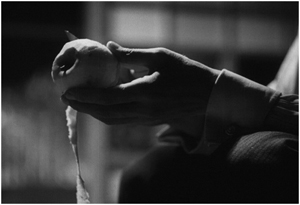FAY GRIM
2007, Hal Hartley, United States / Germany
1st Viewing, DVDTen years after his most highly acclaimed film (Henry Fool), New York indie filmmaker Hal Hartley follows up with this sequel Fay Grim. I’m not sure how necessary this sequel is, and I need to revisit Henry Fool again soon, because I think even if Fay Grim stands on its own it can be much more appreciated in connection with the original. Here the tone has changed and Hartley makes a film that takes itself seriously only somewhat at times. The films strength comes from its pitch-perfect casting which easily blends with Hartley’s sensibilities and style as director and writer. Of course Parker Posey carries the film and again proves why she is one of the very best actresses in independent American filmmaking (if only she could get some respect from mainstream studios). Posey understands the irony and the compassion of the character, right from the open still shots of paranoia to the final close-up look that captures the face of American who is mystified by the happenings of the world. Shot in digital video in four different countries (United States, France, Turkey, and Germany) Fay Grim is a film that reflects upon America’s global situation and its paranoia (heightened by the endless use of slanted camera angels). It is this but it is also a rather funny and enjoyable film, utilizing Hartley’s deadpan comedy and dialogue as well as Posey’s terrific performance. Fay Grim is a bizarre film, but one Hartley’s fans will truly appreciate.
WIDE AWAKE
2007, Alan Berliner, United States
1st Viewing, HBO
Writer, producer, editor, director and subject Alan Berliner’s documentary is neurotic and self-absorbed, but I guess that is the intentions since he is trying to put the audience in a position to understand his mind and his world. He is an insomniac (living and in someways embodying New York), who gets most or his work done at night, while others are asleep. The documentary is certainly entertaining, mostly because of all the old footage and sounds Berliner uses. One of the things he does in the late hours of night is collect and organize all sorts of “stuff”, such as archived film footage, personal and lost family home movies, newspaper images, and most interestingly a file cabinet of sound effects (each drawer is labeled with a sound and when it opens the sound plays). The film is entertaining and interesting and unique and bold of Berliner (and his wife) to complete. Wide Awake is not a great film, but it is engaging and fascinating to see all the clips and footage Berliner incorporates (including the wonderfully moody musical score from That Uncertain Feeling, directed by the great Ernst Lubitsch).
BEFORE SUNSET
2004, Richard Linklater, United States
Repeat Viewing, HBOWhat a gorgeous film this is! As brilliant as Before Sunrise is (and I believe it to be be an absolute masterpiece) Before Sunset is equal- if not better- in every way! I love these films! Much like the first film, it's such a simplistic approach yet reaches depths and complexities of endless philosophical and romantic themes. Ultimately everything centers around the connection or longing of two human souls. While together both films are wonderful, Before Sunset is really a sequel that stands on it's own. What this film does is it takes a second chance at fate. Richard Linklater's direction is fabulous. Once again he features long, elaborate tracking shots as the couple move throughout the backdrop of the city (this time the location is beautiful Paris, which captures an absorbing and breathtaking atmosphere). Ethan Hawke and especially the radiant Julie Delpy deserve equal credit to Linklater, not only for the wonderful recreation of the characters (Jesse and Celine 9 years later), but also for co-writing the brilliant dialogue. They each inhabit their roles to such perfection it's truly a joy to watch. Their conversations are full of intelligence as it displays both humor and heartache in reflecting upon the past 9 years. Time has passed, their lives have changed, even their perspective of life of changed (perhaps more cynical and less hopefully romantic?), yet the true feelings and longing within their soul remains and it is equally painful and beautiful. This is particularly expressed in one of the films most revealing and unforgettable sequences on the tour boat. Every moment of Before Sunset works, as it arrives to it's emotional (and again, very open) ending. There are several interpretations as to what will happen with Jesse and Celine, but much of it relates to an early sequence at Jesse's book singing in which he compared the cynic to the romantic. However you see the film at it's conclusion it's a very thought-provoking and brilliant ending that carries a variety of human emotions: sadness, regret, anger, excitement, and remembrance (highlighted by the wonderful Nina Simone singing 'Just In Time'). Before Sunset is a lovely, poetic, touching, funny, philosophical, and romantic masterpiece that recalls the beauty of the glorious French New Wave. Comparisons aside however, this is easily one of the most PERFECT films ever made. I love it so much!!!



